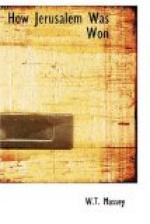A not inconsiderable portion of the front line was supplied with Nile water taken from a canal nearly two hundred miles away. But the Army once at the front depended less upon the waters of that Father of Rivers than it had to do in the long trek across the desert. Then all drinking water came from the Nile. It flowed down the sweet-water canal (if one may be pardoned for calling ‘sweet’ a volume of water so charged with vegetable matter and bacteria that it was harmful for white men even to wash in it), was filtered and siphoned under the Suez Canal at Kantara, where it was chlorinated, and passed through a big pipe line and pumped through in stages into Palestine. The engineers set about improving all local resources over a wide stretch of country which used to be regarded as waterless in summer. Many water levels were tapped, and there was a fair yield. The engineers’ greatest task in moving with the Army during the advance was always the provision of a water supply, and in developing it they conferred on the natives a boon which should make them be remembered with gratitude for many generations.
In the months preceding our attack Royal Engineers were also concerned in improving the means of communication between railway depots and the front line. Before our arrival in this part of Southern Palestine, wheeled traffic was almost unknown among the natives. There was not one metalled roadway, and only comparatively light loads could be transported in wheeled vehicles. The soil between Khan Yunus and Deir el Belah, especially on the west of our railway line, was very sandy, and after the winter rains had knitted it together it began to crumble under the sun’s heat, and it soon cut up badly when two or three limbers had passed over it. The sandy earth was also a great nuisance in the region between Khan Yunus and Shellal, but between Deir el Belah and our Gaza front, excepting on the belt near the sea which was composed of hillocks of sand precisely similar to the Sinai Desert, the earth was firmer and yielded less to the grinding action of wheels. For ordinary heavy military traffic the engineers made good going by taking off about one foot of the top soil and banking it on either side of the road. These tracks lasted very well, but they required constant attention. Ambulances and light motor cars had special arrangements made for them. Hundreds of miles of wire netting were laid on sand in all directions, and these wire roads, which, stretching across bright golden sand, appeared like black bands to observers in aircraft, at first aroused much curiosity among enemy airmen, and it was not until they had made out an ambulance convoy on the move that they realised the purpose of the tracks.




